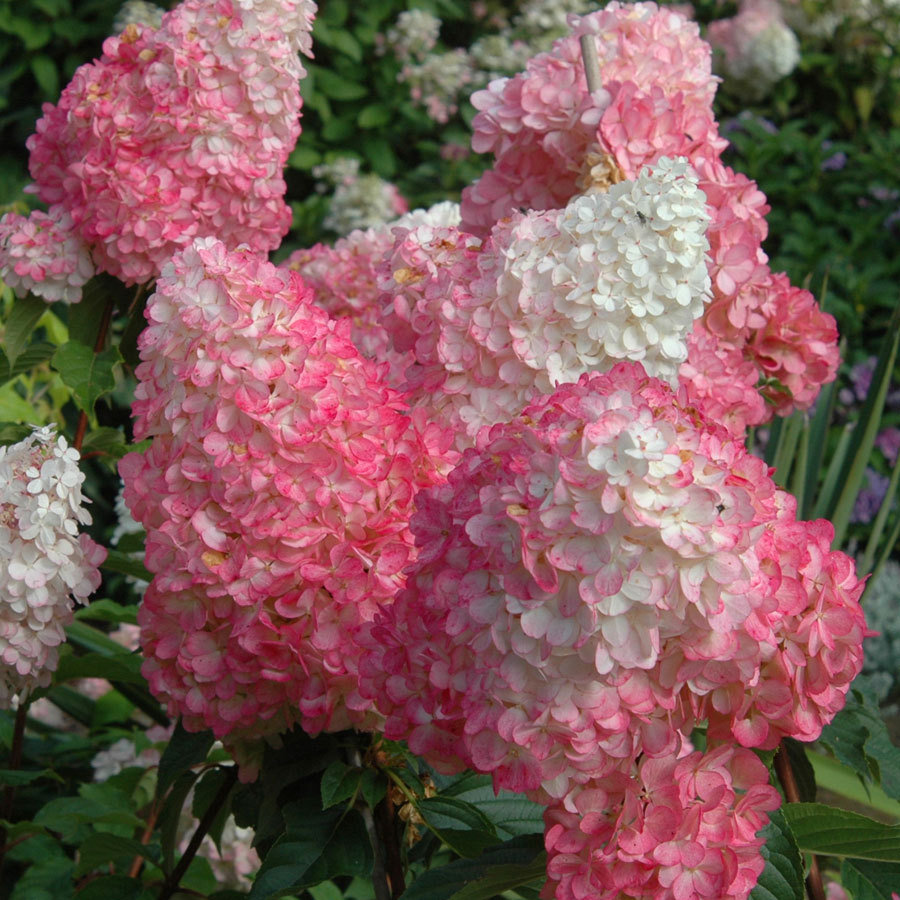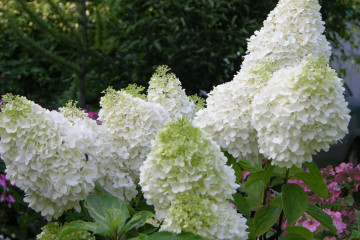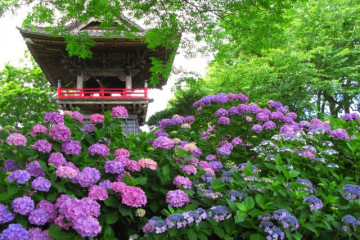Hydrangea red large-leaved Fiery beauty
Content:
Hydrangea is a floral plant introduced to the European continent in the 14th century. At first these beautiful scarlet and white flowers were used by the wealthy French and British. Now hydrangea grows well in almost every garden or park.
Types and varieties of red hydrangeas
Bushes of small height are unpretentious to habitat conditions, they get along well in temperate climates. The family is represented by more than 70 species, differing in the shape and size of the bushes. Garden paths are decorated with caps of beautiful inflorescences; hydrangeas fit well into urban landscape design.
Through the efforts of breeders in the Middle Lane, hydrangeas of various types and varieties can be planted in the form of climbing, stunted, suitable for landscaping parks and gardens. The general characteristics of the known varieties contain the definition of this plant as a large-leaved shrub with flowers of considerable size in the form of scutes, as well as panicles located at the top of the shoots.
Hydrangea large-leaved Fiery beauty
The name of the variety indicates the magnificence of the perennial. Large caps in vibrant reds are often used as decoration in problematic shaded areas.
Large-leaved hydrangea Fiery beauty is characterized by a long flowering period (July-November). The plant is successfully cultivated indoors in containers.
Description of hydrangea Hot Red
An exquisite decoration of the garden suburban area will serve as a novelty of hydrangea with inflorescences in the form of a fireball among the leaves of a dark green color. Planting, care does not require special knowledge and skills in floriculture. Soil preparation, transplanting rules do not differ from general requirements in crop production. It is possible to propagate a hydrangea in the garden in several ways:
- cuttings;
- layering;
- dividing the bush;
- sowing seeds.
This shrub can become the main decoration of the garden.
Hydrangea Alpengluchen
It is a large-leaved fiery red hydrangea. A bright medium-sized variety that successfully grows both in open areas of the garden plot and at home, for example, in a tub or large pot on a sunny balcony. Such a device will bring joy for the whole summer.
The plant belongs to the class of thermophilic varieties, therefore, the bushes should be covered for the winter.
Hortense Red Baron
A beautiful shrub with large bright green ovoid leaves and spectacular flowers that form a dense spherical crown. The variety is fast-growing, thermophilic, demanding on nutrient soil, loves abundant watering. In the second half of summer, it pleases with its lush flowers. Does not get along on calcareous soils.
Hydrangea of this variety is best suited for growing in a box or pot.
Caring for red hydrangeas in the garden
Hydrangea is the garden and greenhouse star of modern Europeans. Many decades ago, when the thermophilic shrub was just brought from Japan, it was necessary to cherish and nourish it. Thanks to active breeding work, hydrangea has acclimatized to the cold, acquired new colors of petals, and care has become easier. People have enriched the experience of growing plants, on the basis of which it is possible to change, to achieve renewal of the color of inflorescences.
For example, a blue hydrangea transplanted from an acidic soil to an alkaline medium turns pink. For flowers grown at home, changing the color of the flowers is easy and simple. It is enough to add a specially prepared mixture to the water, which is watered with the plant to acidify or neutralize acidity, and you can get the desired effect. This property is used when creating landscape design.
Watering mode
There are common features of all types of hydrangeas. These are, first of all, the requirements for regular watering. A shrub growing on sandy soil with a sunny side especially needs abundant irrigation. To conserve water at the roots, it is advisable to use mulch. But paniculate varieties are not afraid of dry weather.
Top dressing
The flora is rich. Hydrangea represents both indoor and garden fauna. Caps-inflorescences flaunting under the sun touch the soul of any person. In such a rich world of varieties and delicate colors, you can find your own flower, close in spirit. But without real care, which consists in leaving, daily feeding, it is difficult for a plant to simply survive.
The growth and development of a green crown requires a large amount of nitrogen fertilizers. Urea plus potassium sulfate gives the desired mixture, which is dissolved in water at a specific ratio. For a bucket of water of 10 liters, it is enough to add 2 tbsp. tablespoons of the mixture (one of each component). Under each bush, 5 liters of mineral fertilizer are applied.
At each stage of development, the hydrangea should receive different types of feeding. The formation of buds and the moment of leaf blooming are different phases. On the eve of flowering, phosphorus and potassium are most needed. These elements are found in superphosphate, which is taken 1 tbsp. spoon and dissolve in 10 liters of water. The green crown is sprayed with the same solution. During the flowering period, processing is carried out three times.
Features of care during flowering
June is the time for the formation of flower buds, the number of which depends on the dressing. During this period, it is advisable to add mineral fertilizers in the form of nitrophoska and agriculture (1 tablespoon of each ingredient per 10 liters of water). In July, hydrangea needs green fertilizer in the form of nettle infusion. Introduce 1 bucket for each bush and additionally 1 bucket of clean water.
For active long flowering in the middle of summer, it is useful to apply a complex fertilizer called flower kemira with a dosage of 1 tbsp. spoon in a bucket of 10 liters of water. By the beginning of August, nitrogenous fertilizing is stopped so that the plants do not become burdened with green mass and overwinter safely. Mineral feeding should be alternated with organic irrigation (bird droppings, slurry).
Features of care during the rest period
After a violent flowering, a long period of dormancy begins. At this time, cleaning of the area and gradual preparation for wintering begins.
Preparing for winter
The winter period for any representative of the flora provides an opportunity to gain strength for the next lush flowering for a long time. In summer, hydrangea will thank you with lush, spectacular flowering for taking care of it in winter. So, winter care involves the performance of some mandatory work. For indoor hydrangea, these are:
- pruning;
- transfer.
For garden hydrangea, some features are taken into account. It is important here to prepare the site in advance, to think over all the nuances. With regard to the soil, you need to choose a place with sufficient moisture, lighting, depending on the variety (light-loving, shade-tolerant). The best place to grow hydrangeas is considered partial shade, so that the bushes are comfortable. Growing conditions must correspond to the natural properties of the bush.
Sanitary cleaning of bushes
Such an event is held after flowering to maintain decorative appeal. When pruning, all weak small shoots are removed, strong ones are left, which must be shortened by half their length. The shrub sheds its foliage after summer, this is the natural preparation of the plant for a long winter dormant period. To increase frost resistance under the bushes, you need to collect all fallen dried leaves and destroy. This contributes to the lignification of young shoots. Before the onset of frost, the last leaves are removed from the bushes. The most apical ones are left, which will protect the flower buds.
Transfer
The hole is prepared with a size of 40 × 40 cm. In group cultivation, planting is carried out at a distance of the bushes up to 1 m from each other. A well-mixed mixture of earth with sand and fertilizers is immersed at the bottom of the hole. A small peat layer and a drainage layer using expanded clay or pebbles are poured on top.
A positive effect is provided by hilling the base of the bushes with a dry layer of soil, as well as mulching, where dry foliage is used as mulch.
Thus, there is nothing difficult in growing red hydrangea flowers. The main thing is to choose a variety that is suitable for the climate, plant it correctly, provide it with watering and fertilizing and cover it for the winter. Then the shrub will thank you with its lush flowering.





















